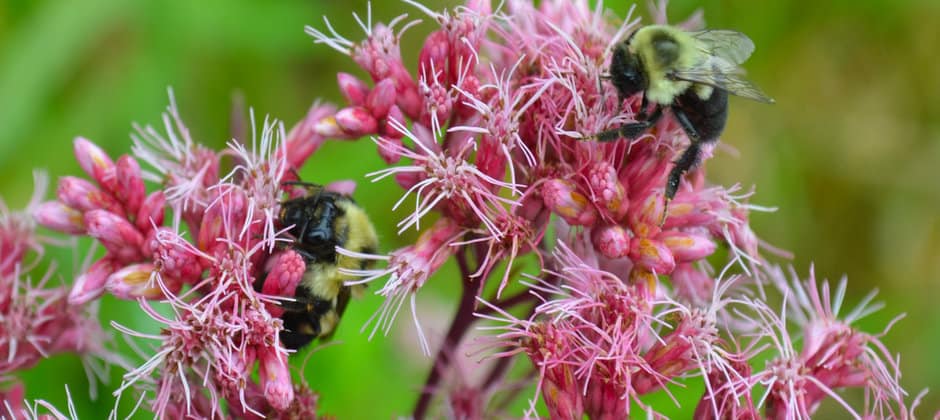Share this article
Flowers bring forage — and infection — to bees
While planting flowers can increase foraging opportunities for common eastern bumble bees, researchers found some of those flowers are associated with higher pathogen infection rates in the bees.
Pollinator species play an important role in agriculture and human food security around the world, but their populations are declining. Disease is one of the factors behind those declines, said Lynn Adler, a biologist at the University of Massachusetts-Amherst, but “we know very, very little about where [pollinators] are acquiring those infections or whether there are factors in the landscape that might affect the likelihood of becoming infected.”
In a study in Proceedings of the National Academy of Sciences, Adler and her co-authors looked at how the different nectar plants people often plant in gardens or near agricultural fields might impact common eastern bumblebee (Bombus impatiens) pathogen loads and colony success. “We were really just interested in whether what you choose to plant in a pollinator habitat could have an impact on disease in the bees as well as affecting bee performance,” Adler said.
On an agricultural research farm in western Massachusetts, Adler and her team set up three types of treatments in tented habitats: one control tent with only canola (Brassica napus) crops, one with canola crops and additional “high infection” plants, and one with canola crops and additional “low infection” plants. Adler said she chose canola as the control because it is both a major foraging source for bees and a widely produced crop in the U.S. High and low infection plants, meanwhile, were those that Adler identified in 2018 research as being associated with higher and lower pathogen loads in bees.
In the 2018 research, Adler placed equal amounts of pathogens on different flowers, let bees forage on the flowers, and then compared subsequent pathogen loads in the bees. Plants including sunflower and thyme were associated with lower pathogen loads in the bees and were identified as low infection plants. Meanwhile, purple loosestrife and other plants resulted in higher infection in the bees. Adler said that plants with higher number of reproductive structures on their stalks tended to cause higher infection in bees. However, while high and low infection plant species have been identified, it is still unclear why exactly certain plants cause higher or lower infection in bees.
In the new study, the researchers released a microcolony of 15 bees in each tent to forage for two weeks. At the end of each of five two-week trials, Adler and her colleagues evaluated each colony’s infection level of a common but relatively benign bee pathogen called Crithidia bombi. The gut parasite is associated with reduced bee-foraging abilities and mortality in food-compromised bees and it also reduces queen bees’ ability to found new colonies. To measure the level of infection with the parasite, the researchers dissected individual bees and counted the parasite cells in their intestines. They also measured the bees’ success by looking at adult survival and reproductive output, which included the amount and weight of eggs and larvae produced.
The researchers found that bees were infected by Crithidia twice as much in tents with “high infection” plants than in those with “low infection” plants. Bees in tents that had only canola and no extra flowers, meanwhile, had an intermediate level of infection. “That’s really exciting, because it suggests that plants are playing a role in disease dynamics in pollinators,” Adler said.
Pollinator plants don’t just matter for infection rates, though. As a food resource, they also play a major role in bee colony success. The team found that in tents with the extra nectar plants, bees had higher survival rates and reproductive output than in the canola-only tents, regardless of their pathogen loads.
“Even in high infection tents where the bees had high infection loads, it really didn’t impact their performance very much,” Adler said. Having more food was more important for their performance, she said, because “bees did really lousy in tents with only canola where there was very little nectar.” Although the bees were subject to higher Crithidia infection by foraging on high infection flowers compared to the canola-only tent, the extra food seemed to be worth it.
Adler cautioned that the study looked at only one bumblebee species and one pathogen. They also studied the bees in tents rather than a natural environment. She said she isn’t ready to use the results to tell people to stop planting certain high infection nectar plants.
“I’d like to look at some more bees and some more pathogens before taking a plant that people thought of as a good pollinator habitat plant and taking it off their list,” she said. “Telling people not to plant some really nice natives that are good resources seems to me a little irresponsible at this point.”
Header Image: A new experimental study found that pathogen loads in common eastern bumblebees depended on which nectar plants they foraged on. Credit: U.S. Fish & Wildlife Service Midwest Region








